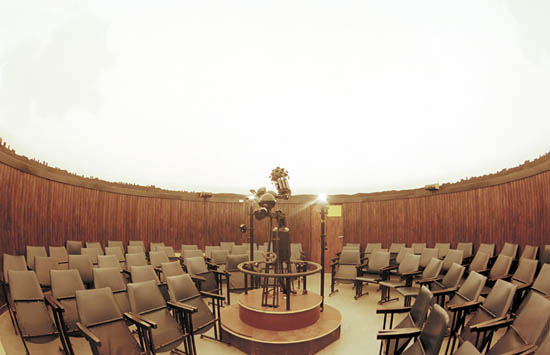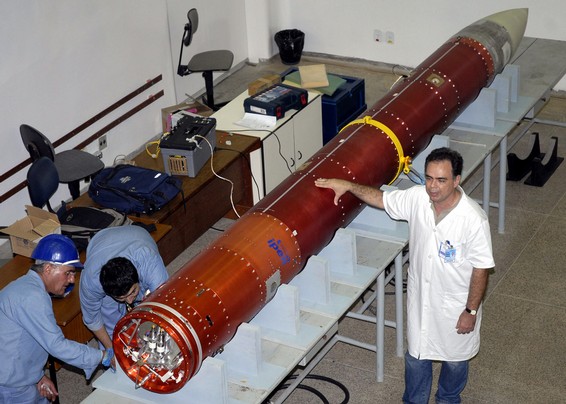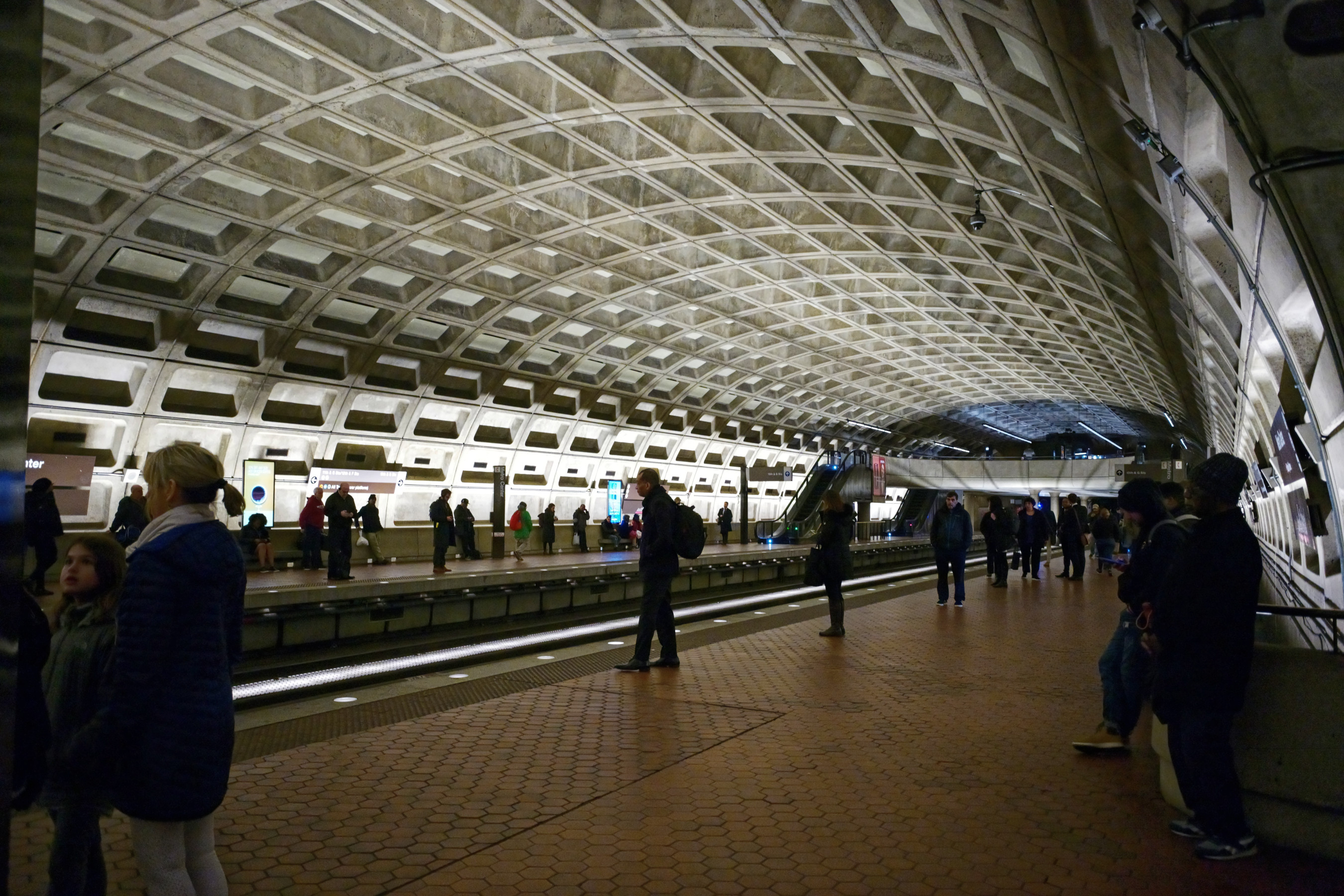|
Brasília Planetarium
The Brasília Planetarium Luiz Cruls (), colloquially known as the Brasília Planetarium or the Planetarium of Brasília, is a planetarium located in Brasília, in the Federal District. Inaugurated on 15 March 1974, it was designed by architect Sérgio Bernandes using a Brutalist style. It is part of the Monumental Axis' Cultural Diffusion Sector (), being located between the Brasília TV Tower, the Ulysses Guimarães Convention Center, and near the Estádio Nacional Mané Garrincha and the Brasília Choro Club. The Planetarium is part of the Brazilian Association of Planetariums. History The Brasília Planetarium was initially inaugurated in March 1974, being designed by Sérgio Bernandes. In 2006, it was closed for refurbishing due to several structural problems, which lasted until 2013. It was reopened following construction work on 11 December 2013. Charactersitics The planetarium was designed by architect Sérgio Bernandes, with a Brutalist architectural style, having b ... [...More Info...] [...Related Items...] OR: [Wikipedia] [Google] [Baidu] |
Brasília
Brasília ( ; ) is the capital city, capital of Brazil and Federal District (Brazil), Federal District. Located in the Brazilian highlands in the country's Central-West Region, Brazil, Central-West region, it was founded by President Juscelino Kubitschek on 21 April 1960, to replace Rio de Janeiro as the national capital. Brasília is Brazil's List of cities in Brazil by population, third-most populous city after São Paulo and Rio de Janeiro, with a population of 2.8 million. Among major Latin American cities, it has the highest GDP per capita. Brasília is a Planned community, planned city developed by Lúcio Costa, Oscar Niemeyer and Joaquim Cardozo in 1956 in a scheme to move the capital from Rio de Janeiro to a more central location. The landscape architect was Roberto Burle Marx. The city's design divides it into numbered blocks as well as sectors for specified activities, such as the Hotel Sector, the Banking Sector, and the Embassy Sector. Brasília was inscribed as a UN ... [...More Info...] [...Related Items...] OR: [Wikipedia] [Google] [Baidu] |
International Space Station
The International Space Station (ISS) is a large space station that was Assembly of the International Space Station, assembled and is maintained in low Earth orbit by a collaboration of five space agencies and their contractors: NASA (United States), Roscosmos (Russia), European Space Agency, ESA (Europe), JAXA (Japan), and Canadian Space Agency, CSA (Canada). As the largest space station ever constructed, it primarily serves as a platform for conducting scientific experiments in microgravity and studying the space environment. The station is divided into two main sections: the Russian Orbital Segment (ROS), developed by Roscosmos, and the US Orbital Segment (USOS), built by NASA, ESA, JAXA, and CSA. A striking feature of the ISS is the Integrated Truss Structure, which connect the station’s vast system of solar panels and Spacecraft thermal control, radiators to its pressurized modules. These modules support diverse functions, including scientific research, crew habitation, ... [...More Info...] [...Related Items...] OR: [Wikipedia] [Google] [Baidu] |
Tourist Attractions In Brasília
Tourism is travel for pleasure, and the commercial activity of providing and supporting such travel. UN Tourism defines tourism more generally, in terms which go "beyond the common perception of tourism as being limited to holiday activity only", as people "travelling to and staying in places outside their usual environment for not more than one consecutive year for leisure and not less than 24 hours, business and other purposes". Tourism can be domestic (within the traveller's own country) or international. International tourism has both incoming and outgoing implications on a country's balance of payments. Between the second half of 2008 and the end of 2009, tourism numbers declined due to a severe economic slowdown (see Great Recession) and the outbreak of the 2009 H1N1 influenza virus. These numbers, however, recovered until the COVID-19 pandemic put an abrupt end to the growth. The United Nations World Tourism Organization has estimated that global international tourist a ... [...More Info...] [...Related Items...] OR: [Wikipedia] [Google] [Baidu] |
Buildings And Structures In Brasília
A building or edifice is an enclosed structure with a roof, walls and windows, usually standing permanently in one place, such as a house or factory. Buildings come in a variety of sizes, shapes, and functions, and have been adapted throughout history for numerous factors, from building materials available, to weather conditions, land prices, ground conditions, specific uses, prestige, and aesthetic reasons. To better understand the concept, see ''Nonbuilding structure'' for contrast. Buildings serve several societal needs – occupancy, primarily as shelter from weather, security, living space, privacy, to store belongings, and to comfortably live and work. A building as a shelter represents a physical separation of the human habitat (a place of comfort and safety) from the ''outside'' (a place that may be harsh and harmful at times). buildings have been objects or canvasses of much artistic expression. In recent years, interest in sustainable planning and building pract ... [...More Info...] [...Related Items...] OR: [Wikipedia] [Google] [Baidu] |
Planetarium
A planetarium (: planetariums or planetaria) is a theatre built primarily for presenting educational and entertaining shows about astronomy and the night sky, or for training in celestial navigation. A dominant feature of most planetariums is the large dome-shaped projection screen onto which scenes of stars, planets, and other celestial objects can be made to appear and move realistically to simulate their motion. The projection can be created in various ways, such as a star ball, slide projector, video, fulldome projector systems, and lasers. Typical systems can be set to simulate the sky at any point in time, past or present, and often to depict the night sky as it would appear from any point of latitude on Earth. Planetaria range in size from the 37 meter dome in St. Petersburg, Russia (called "Planetarium No 1") to three-meter inflatable portable domes where attendees sit on the floor. The largest planetarium in the Western Hemisphere is the Jennifer Chalsty Planetariu ... [...More Info...] [...Related Items...] OR: [Wikipedia] [Google] [Baidu] |
List Of Planetariums
This entry is a list of permanent planetariums across the world. Permanent planetariums Planetariums are ordered by continent and then by country in alphabetical order. The planetariums are listed in the following format: ''name'', ''city''. The International Planetarium Society has a more complete list on its website. Africa Algeria * Complexe Culturel Abdelwahab Salim, Tipaza * Planetarium de Ghardaia, Ghardaia Egypt * Arab Academy for Science and Technology Planetarium, Alexandria * The Child Museum, Cairo * Planetarium Science Center, Alexandria * Suez Discovery & Science Center, Suez Ghana * Ghana Planetarium, Accra Libya * Planetarium of Tripoli, Al-Quba Al-Falakia, Tripoli, Libya South Africa * Iziko Planetarium at the Iziko South African Museum, Cape Town * Johannesburg Planetarium at University of the Witwatersrand, Johannesburg * Sutherland Planetarium * Naval Hill Planetarium, Bloemfontein Tunisia * Planetarium of Tunis Science City, Tunis Asia Banglade ... [...More Info...] [...Related Items...] OR: [Wikipedia] [Google] [Baidu] |
VSB-30
VSB-30 - "''Veículo de Sondagem Booster – 30"'' (Booster Sounding Vehicle) or "''Foguete Suborbital VSB-30"'' is the designation of a Brazilian sounding rocket, which replaced the Skylark (rocket), Skylark rocket at Esrange. The VSB-30 is based on the VS-30 rocket (S-30 engine) with the addition of a booster stage (S-31 engine). Development started in 2000 in cooperation with German Aerospace Center, DLR. The rocket can carry a payload of 400 kg to an altitude of 270 km. It has a liftoff thrust of 240 kN and a total mass of 2570 kg. It has a diameter of 0.56 m and a length of 12.6 m. VSB-30 was first launched on October 23, 2004, at Alcântara Launch Center. The first launch at Esrange took place on December 1, 2005. Flights VSB-30 performed the following flights: Characteristics VSB-30 has the following configuration: *Length (mm): 12600 *Stages: 2 *Payload Mass (kg): 400 *Diameter (mm): 570 *Total takeoff mass (kg): 2570 *Apogee (Max km): 270 Stages ... [...More Info...] [...Related Items...] OR: [Wikipedia] [Google] [Baidu] |
VLS-1
The ''VLS-1'' () was the Brazilian Space Agency's main satellite launch vehicle. The launch vehicle would have been capable of launching satellites into orbit. The launch site was located at the Alcântara Launch Center due to its proximity to the equator. Associated vehicles include the Sonda (rocket)#Sonda I, Sonda I, Sonda (rocket)#Sonda II, Sonda II, Sonda (rocket)#Sonda III, Sonda III and Sonda (rocket)#Sonda IV, Sonda IV, the VS-30, VS-40 and VSB-30. The VLS was cancelled after decades of development and high expenditures with poor results and a failed association with Ukraine that slowed the program for years. History VLS-1 development started in 1984, after the first launch of the Sonda IV rocket. To date, three prototypes have been built and two launches attempted, departing from the Alcântara Launch Center. During the V1 and V2 prototype launches (VLS-1 V1 and VLS-1 V2) technical problems prevented mission success, but allowed the testing of several vehicle components ... [...More Info...] [...Related Items...] OR: [Wikipedia] [Google] [Baidu] |
Brazilian Space Agency
The Brazilian Space Agency (; AEB) is the civilian authority in Brazil responsible for the country's Space exploration, space program. It operates a spaceport at Centro de Lançamento de Alcântara, Alcântara, and a rocket launch site at Centro de Lançamento de Barreira do Inferno, Barreira do Inferno. It is the largest and most prominent space agency in Latin America. The Brazilian Space Agency is the institutional successor of Brazilian space program, Brazil's space program, which had been managed by the Military of Brazil, Brazilian military until its transfer to civilian control on 10 February 1994. It suffered a major setback in 2003, when a Brazilian rocket explosion, rocket explosion killed 21 technicians. Brazil successfully launched its first rocket into space, the VSB-30, on 23 October 2004 from the Centro de Lançamento de Alcântara, Alcântara Launch Center; several other successful launches have followed. Brazil was briefly a partner in the International Space St ... [...More Info...] [...Related Items...] OR: [Wikipedia] [Google] [Baidu] |
Soyuz TMA-8
Soyuz TMA-8 was a Soyuz spacecraft, Soyuz mission to the International Space Station (ISS) launched by a Soyuz FG launch vehicle. Crew Soyuz TMA-8 was a transport mission for portions of the International Space Station (ISS) ''Expedition 13'' crew. The flight delivered ISS Commander Pavel Vinogradov and ISS Flight Engineer Jeffrey Williams (astronaut), Jeffrey Williams to the station to replace ''Expedition 12'' crew members. Flight Engineer Marcos Pontes joined the TMA-8 crew for the ascent and docking with ISS, spent approximately seven days aboard the ISS conducting experiments as part of the Missão Centenário, then returned to Earth with the outgoing members of ''Expedition 12'' aboard Soyuz TMA-7. Vinogradov and Williams were joined on their return trip to Earth by Spaceflight Participant Anousheh Ansari who launched aboard Soyuz TMA-9 and spent approximately eight days aboard ISS conducting experiments for the European Space Agency. Back-up crew Docking with ISS * ... [...More Info...] [...Related Items...] OR: [Wikipedia] [Google] [Baidu] |
Missão Centenário
The Missão Centenário was born of an agreement between the Brazilian Space Agency (AEB) and the Roscosmos on October 18, 2005. The main objective of this treaty would be to send the first Brazilian into space, Lt. Col. Aviator Marcos Pontes. The name of the mission is a reference to the commemoration of the centenary of the first crewed flight of a Brazilian-designed aircraft, the Santos-Dumont 14-bis, in Paris on October 23, 1906. The vehicle used for launching the mission was the Roscosmos Soyuz TMA-8 spacecraft, and its launch took place on March 30, 2006 (11:30 p.m Brasília time) at the Baikonur Cosmodrome (Kazakhstan) to International Space Station (ISS). Bilateral agreement for the mission The ''Missão Centenário'' was made possible by an commercial agreement signed in October 2005 between Brazil and Russia, with representatives of the Brazilian Space Agency (AEB) and Roscosmos. As a result, astronaut Marcos Cesar Pontes began training in Star City, a training ... [...More Info...] [...Related Items...] OR: [Wikipedia] [Google] [Baidu] |
Brutalism
Brutalist architecture is an architectural style that emerged during the 1950s in the United Kingdom, among the reconstruction projects of the post-war era. Brutalist buildings are characterised by minimalist constructions that showcase the bare building materials and structural elements over decorative design. The style commonly makes use of exposed, unpainted concrete or brick, angular geometric shapes and a predominantly monochrome colour palette; other materials, such as steel, timber, and glass, are also featured. Descended from Modernism, brutalism is said to be a reaction against the nostalgia of architecture in the 1940s. Derived from the Swedish phrase ''nybrutalism'', the term "new brutalism" was first used by British architects Alison and Peter Smithson for their pioneering approach to design. The style was further popularised in a 1955 essay by architectural critic Reyner Banham, who also associated the movement with the French phrases '' béton brut'' ("raw c ... [...More Info...] [...Related Items...] OR: [Wikipedia] [Google] [Baidu] |









